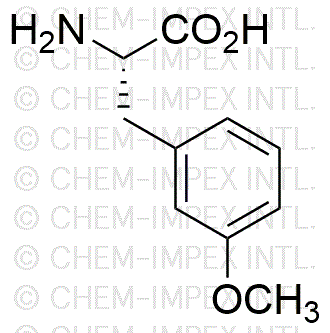L-3-Methoxyphenylalanine is widely utilized in research focused on:
- Neuroscience Research: This compound is studied for its potential effects on neurotransmitter systems, particularly in understanding mood disorders and neurodegenerative diseases.
- Pharmaceutical Development: It serves as a building block in the synthesis of novel drugs, especially those targeting metabolic pathways and neurological functions.
- Biochemical Studies: Researchers use it to investigate protein interactions and enzyme activities, providing insights into cellular processes and disease mechanisms.
- Food Industry: Its properties are explored in the development of flavor enhancers or nutritional supplements, appealing to health-conscious consumers.
- Cosmetic Formulations: The compound is examined for its antioxidant properties, making it a candidate for skin care products aimed at improving skin health and appearance.
Informations générales
Propriétés
Sécurité et réglementation
Applications
L-3-Methoxyphenylalanine is widely utilized in research focused on:
- Neuroscience Research: This compound is studied for its potential effects on neurotransmitter systems, particularly in understanding mood disorders and neurodegenerative diseases.
- Pharmaceutical Development: It serves as a building block in the synthesis of novel drugs, especially those targeting metabolic pathways and neurological functions.
- Biochemical Studies: Researchers use it to investigate protein interactions and enzyme activities, providing insights into cellular processes and disease mechanisms.
- Food Industry: Its properties are explored in the development of flavor enhancers or nutritional supplements, appealing to health-conscious consumers.
- Cosmetic Formulations: The compound is examined for its antioxidant properties, making it a candidate for skin care products aimed at improving skin health and appearance.
Documents
Fiches de données de sécurité (FDS)
La FDS fournit des informations de sécurité complètes sur la manipulation, le stockage et l’élimination du produit.
Spécifications du produit (PS)
Le PS fournit une description complète des propriétés du produit, notamment sa composition chimique, son état physique, sa pureté et les exigences de stockage. Il détaille également les plages de qualité acceptables et les applications prévues du produit.
Certificats d'analyse (COA)
Recherchez des certificats d'analyse (COA) en saisissant le numéro de lot du produit. Les numéros de lot et de lot se trouvent sur l'étiquette d'un produit, après les mots « Lot » ou « Lot de fabrication ».
Numéro de catalogue
Numéro de lot/série
Certificats d'origine (COO)
Ce certificat d'exploitation confirme le pays dans lequel le produit a été fabriqué, et détaille également les matériaux et composants utilisés et s'il est issu de sources naturelles, synthétiques ou autres sources spécifiques. Ce certificat peut être requis pour les douanes, le commerce et la conformité réglementaire.
Numéro de catalogue
Numéro de lot/série
Fiches de données de sécurité (FDS)
La FDS fournit des informations de sécurité complètes sur la manipulation, le stockage et l’élimination du produit.
DownloadSpécifications du produit (PS)
Le PS fournit une description complète des propriétés du produit, notamment sa composition chimique, son état physique, sa pureté et les exigences de stockage. Il détaille également les plages de qualité acceptables et les applications prévues du produit.
DownloadCertificats d'analyse (COA)
Recherchez des certificats d'analyse (COA) en saisissant le numéro de lot du produit. Les numéros de lot et de lot se trouvent sur l'étiquette d'un produit, après les mots « Lot » ou « Lot de fabrication ».
Numéro de catalogue
Numéro de lot/série
Certificats d'origine (COO)
Ce certificat d'exploitation confirme le pays dans lequel le produit a été fabriqué, et détaille également les matériaux et composants utilisés et s'il est issu de sources naturelles, synthétiques ou autres sources spécifiques. Ce certificat peut être requis pour les douanes, le commerce et la conformité réglementaire.


